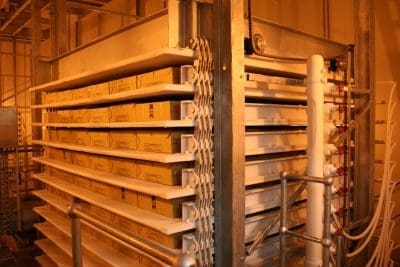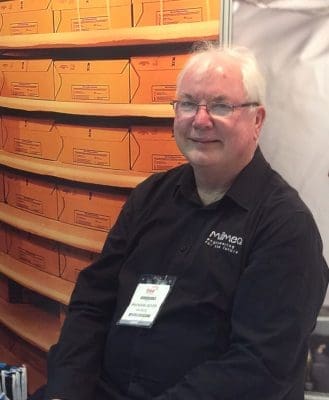WHAT’S driven the massive investment by Australian red meat processors in large-scale plate freezing technology over the past few years?
Beef Central this week takes a look at a piece of somewhat obscure and perhaps little-appreciated processing technology which in no small way is helping consolidate Australia’s reputation as the world’s best beef exporter, based on quality, consistency and product performance.
 Australia is almost unique in the use of large-scale plate freezers, accounting for an estimated 98 percent of the systems in use in the food industry worldwide
Australia is almost unique in the use of large-scale plate freezers, accounting for an estimated 98 percent of the systems in use in the food industry worldwide
Refrigeration engineers Milmeq says it has installed 190 plate freezers in Australia, the majority used in meat processing. And there’s been a sharp rise in installations in the past three to four years, all but one of which have gone into meat processing applications. The largest units can cost up to $10 million each.
Virtually all of Australia’s top 20 red meat processors now use large-scale plate freezers in their operations. JBS, Teys, NH Foods and Thomas Foods International are all heavily committed to the technology.
A large installation was completed at Teys Beenleigh (Qld) last year; and more recent projects have gone in at Northern Cooperative Meat Co at Casino, NSW; and Linley Valley in WA. Just three weeks ago, the latest unit was commissioned at John Dee near Warwick (see yesterday’s separate article).
Sheep processing facilities have also been active, including a large installation last year at Fletcher International’s Dubbo mutton and lamb plant.
JBS Dinmore, the largest beef processing plant in the southern hemisphere, operates no less than ten of the large-scale plater freezer units, allowing the facility to freeze up to 800 tonnes of carton meat daily. The compelling performance reasons why Australian meat processors are making these investment commitments in plate freezing are set out elsewhere in this article.
Australia’s dedicated export focus
The Australian beef industry’s heavy orientation towards export is one reason why plate freezers have been adopted so widely in red meat processing in this country over the past few years.
Last year, more than 70pc of all beef produced in Australia went into export markets, and of that, almost 740,000t, or 72pc, went out in in frozen form.
In contrast, adoption of large-scale plate freezers in competing beef producing countries overseas has been remarkably low. In the US for example, about 90pc of beef is consumed domestically, and US exports tend to be in higher-end chilled product. This removes some of the need for plate freezer infrastructure. In South America, there is almost no use of plate freezers yet in beef processing, but the region is seen as a potential growth market for the technology.
One factor has clearly sparked Australia’s recent massive investment in plate freezers is processor profitability. The high margins enjoyed by processors during 2014-15 years – when slaughter cattle were cheap and abundant due to drought conditions, and international beef demand exploded with the arrival of new markets like China – has been a big driver in investment.
As bad as conditions are currently for processors, those high-profit years provided a ‘piggy bank’ which is now being re-invested in expensive plant infrastructure like plate freezers, to try to stay ahead of international export competition.

Milmeq’s Brendan Dever has been involved with plate freezing development and installation since 1985
Business development specialist with Milmeq, Brendan Dever, has seen a lot of changes in processing over the past 30 years, since working on the first plater freezer installation in 1986.
He agrees that profitability had sparked the rush of installations seen in recent years.
“We saw a real drought in orders for plate freezing systems between around 2009 and 2013,” he told Beef Central during a recent interview.
That coincided with the global financial crisis, and the lack of processor profitability during the very wet years of 2011-12, when producers held cattle back to build herds, forcing processors to pay higher prices for stock.
“Another factor was the movement in the A$,” Mr Dever said. “In the years leading up to 2014, quite a lot of our processor clients told us that when the A$ went below US85-90c in value, they would start talking again about buying plate freezers. And that’s exactly what happened,” he said.
What are plate freezers, and why are they so special?
As the name suggests, plate freezers are composed of an insulated room that holds banks of large, horizontal freezing plates positioned within a steel frame. Liquid ammonia circulates through the movable plates, enabling them to rapidly and efficiently cool cartons of meat by transferring heat by conduction from the product to the evaporator. Up to 40 levels of plates, called stations, stacked up to 20 metres high, are included in some systems.
Plate freezers replace conventional blast freezing tunnels, which are simply insulated coldrooms circulating fan-forced cold air.
While smaller plate freezing systems have been in use worldwide for decades, they were limited to freezing thin carton blocks, no deeper than 75mm, typically used for seafood. It was the Australian-development of so-called large-scale plate freezers that allowed typical 27kg meat cartons up to 175mm deep to be handled, that was the catalyst for adoption in beef plants.
The first prototype designed by Milmeq founder Klaus Visser was installed at Tancreds Meatworks at Beaudesert in 1985, under a Federal Government-backed project designed to deliver greater efficiencies and productivity in red meat processing. The old CSIRO Meat Research Laboratory at Cannon Hill was also heavily involved.
While the original designs were small, manually-loaded setups handing only 100-200 cartons at a time, modern automatically-loaded and unloaded systems range anywhere up to 3000 cartons in capacity. Sometimes multiple systems are installed in the same plant. New innovations, including single-station opening, are providing further attractions for smaller-scale plants and more efficient use.
Weighing up the advantages
Installation of a modern plate freezer facility can cost more than $10 million for the largest applications, including the insulated building itself and automated loading and unloading. But Milmeq says it also does a lot of installations in smaller factories in the $1-$4 million range. Total investment in the technology may have topped $50-$80 million in the past three or four years, one estimate suggested.
Plate freezers may carry an eye-watering installation cost, but once in operation, offer a host of advantages. The mains ones include:
Better presentation:
Cartons handled in a conventional blast freezer can distort and ‘bow’ as the product freezes and expands. This can create problems with stacking and pallet stability, and can compromise the total volume of beef than can be loaded into a shipping container. Cartons frozen in a plate freezer remain absolutely square, like bricks, because of the flat-sided plate compression from both sides. Some processors claim they can load an additional 1.5 tonnes of plate-frozen product into a 20-foot export container, because of better carton shape. Equally at the other end, the product opens-up and transports much better.
Shorter freezing cycles:
A typical conventional airblast freezer will take 48 hours to fully-freeze a load of 27kg meat cartons, meaning twice as much capacity is needed to freeze each day’s kill. In contrast, much more efficient plate freezers work on a 24-hour freezing cycle (many complete the job in 16-20 hours), meaning only half-as much capacity is needed for each day’s kill. That, in turn, provides an inventory saving, meaning the processor needs to ‘own’ one day’s less production between slaughtering and market.
Energy efficiency:
In round numbers, a typical plate freezer installation will use about 90Kw of electricity to freeze one tonne of meat. Compare that with even the most modern air-blast style freezers which use about 125kW/t, and it represents an energy saving of around 30pc.
Food safety, meat quality:
More rapid, even freezing produces a better quality product when thawed, and especially in items like offals, has significant food safety implications. Essentially, quicker cooling time means less chance for bacterial development.
